Great Moments In Harbaugh: 1985 Minnesota

Previously: 1984 Miami, 1985 Notre Dame, 1985 South Carolina
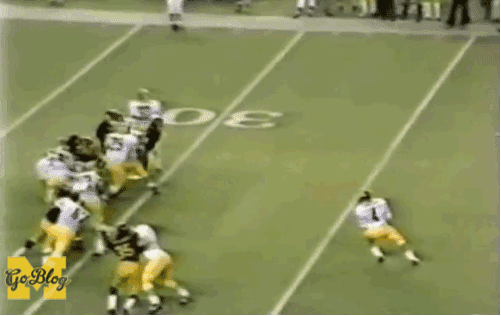
The Highlights: WolverineHistorian
The Setup: After thumping South Carolina on the road, Michigan won their next three games—against Maryland, Wisconsin, and Michigan State—by a combined score of 84-6. That set up a #1 vs. #2 matchup at Iowa that the Hawkeyes won, 12-10, thanks to four field goals and a dominant defensive performance. A 3-3 tie against Illinois two weeks later dropped Michigan to #9 in the polls, and while they bounced back with a blowout of Purdue, a trip to Minnesota looked like a classic trap game the week before The Game.
The Gophers, coached by Lou Holtz, entered the game at 6-3. Two of those losses, however, came in close games against top-five teams, Oklahoma and Ohio State, at the Metrodome. Add in their road loss to Michigan State, and their three defeats came by a combined 15 points. Many felt the Gophers were due for an upset. It wouldn't come against Michigan.
[Hit THE JUMP.]
The Game: I won't bother with the blow-by-blow; Michigan dispelled any concern that they'd overlook Minnesota early, bashing their way through the Gopher defense to set up a short Gerald White touchdown, then cashing in a Minnesota fumble for a field goal for a 10-0 first quarter lead.
Then Harbaugh blew the game open with effective deep passing, especially to his 6'8" split end, Paul Jokisch. Their first scoring connection is at the top of the page. Jokisch's second touchdown catch was, well...
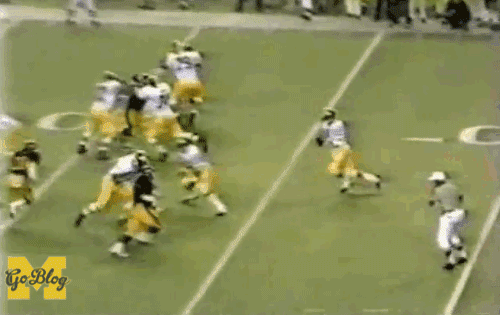
...not a catch, but apparently The Process (Not That Process) was very different in those days. That was ruled a touchdown. Really. With a little help from the zebras, Jokisch finished this game with five catches for 119 yards and two scores.
I've somehow made it this far in a series focusing on Harbaugh's career without mentioning tight end Eric Kattus, who posted a 38-582-8 stat line in 1985 after entering his senior season with seven career catches. As his yards per catch indicates, Kattus proved much more than an underneath option; he could stretch the field and make some impressive downfield receptions:
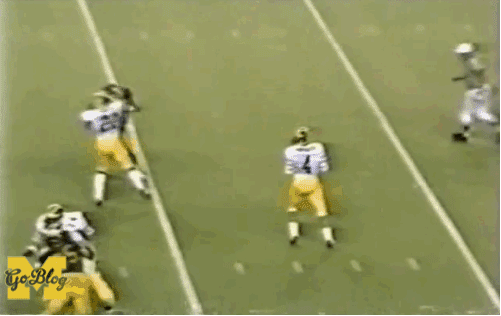
I can't watch this play without hearing "RIGHT FOOT, THROW"
Minnesota was the fourth of five games that season in which Kattus tallied at least 60 receiving yards, a very impressive mark given the run-heavy style of play in those days.
Thanks in large part to Jokisch and Kattus, Michigan's offense dominated despite a subpar day on the ground. The Gophers could only move the ball in fits and spurts against the stellar '85 defense. The front seven was well-prepared for Holtz's option attack:

To further break things open, Gilvanni Johnson took a punt back 84 yards for a touchdown. Michigan would go on to win 48-7, recording all their points in the first three quarters before calling off the dogs. The victory moved the Wolverines to 8-1-1 and #6 in the polls. The next week, they'd welcome #12 Ohio State to Michigan Stadium. That, of course, will be covered in detail in a later post.
The Harbaugh: This was one of Harbaugh's best statistical games at Michigan. He played mistake-free football, completing 13 of 18 passes for 243 yards (13.5 YPA), three TDs, and no picks. The Gophers had no answer for Harbaugh throwing over the top, and he didn't stop until the game was well out of reach.
The Most '80s Screencap of the Game: A two-for-one for this game. First, a full-name-on-back jersey:
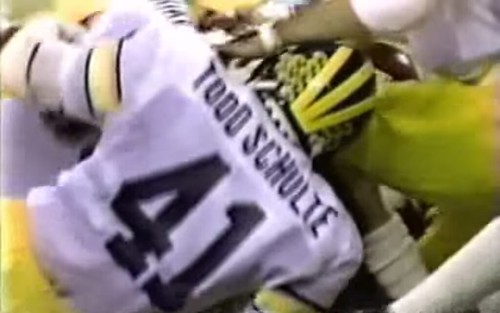
Todd Schulte and Tim Schulte, hailing from Villa Hills, Kentucky, were both junior linebackers on the '85 squad; they'd each start a couple games the next season, according to the Bentley archive.
The most '80s thing, however, is Minnesota lining up in a Wishbone formation with their lone wideout assuming a three-point stance:
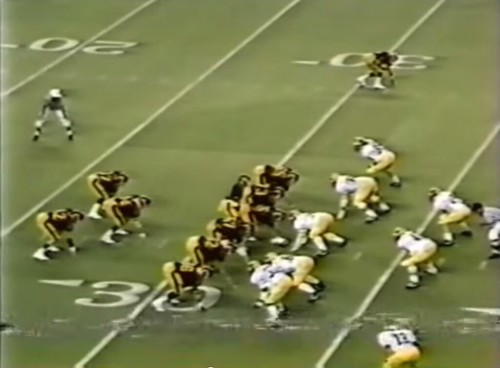
It's amazing that innovative football breakthroughs of the not-so-distant past included "hey, since we don't have starting blocks, maybe that guy should just stand up."
243 yards passing in a win must have given Bo heartburn.
My most vivid memory of the Minnesota game in 1985 was that of Mike Hammerstein sacking Rickey Foggie while he was still dropping back into the pocket. He had absolutely no time to set up before he was crushed. Hammerstein and Messner were an awesome duo!
Nice post, Ace.
I believe that PAT for the Gophers was the first kicked extra point made on the season against UM.
Ah ... the wishbone.
I remember a Joe Falls article way back in the mid-70's where he wondered whether it was the "unstoppable" offense. Oklahoma and Texas were mauling people with it.
There was no answer to it ... until there was. I don't recall what the defensive counter-measure was ... perhaps someone with some X's and O's smarts could weigh in.
The lone wide-out brings back memories of Jim Smith for Michigan back in the 70's. Bob Ufer: "Two tight ends and a balanced line, Huckleby deep and Davis close ... Ricky Leach under center ..." That's 10 guys *not* called a wide receiver. Smith would line up way out there and look so lonely all by himself. :-)
Several reasons:
1. Speed, especially at DT, MLB, OLB as they can quickly pentrate and take away kick out blockers for outside runs. As defenses became faster it shortened the field further and mistakes could be managed better (no one missed tackle =TD)
2. Out shined by passing- avg yards per play fell dramatically behind passing offenses
3. Maybe it belongs attached to #1, but size in general, as the WB oline wasn't big but fast/agile. When D linemen gained size and speed it eliminated options for WB and once more predicatable became stoppable
4. Difficult to teach, hard to find right QB (ideally can hit open WR and make quick line reads/handoffs and keep ball on runs - oh and stay healthly good luck finding 2-3 per team). With more freshman wanting to play it became harder to talk them into 1-2 years sitting in order to perfect line pulls.
5. Boring as sh*t and I prayed every game it would go away (maybe not valid reason but it was very dull to watch 3-4 yard runs over and over and over).
6. highly susceptible to negative plays running entire drive- hard to make up for long distance 3rd downs, any set back on 1-2nd down usually put them into passing game at which they were subpar
7. You could take far inferior players and create a spread offense and out score WB team
Those are just some of the reason's I remember WB going from #1 offensive selection of the top 10 CF teams to high school dream offense in the mid/late 90's
Miami answered some of the better 80's OU wishbone teams with the "Miami 4-3 Over"defense that is credited with introducing speed as the primary require of a defense and basically ending the reign of the triple-option in football.
essentially using bigger & faster d lineman that shot past guards on the pull...also awesome to watch a DT hit a qb before the hand off due to their speed through the hole...
http://bleacherreport.com/articles/1999358-nfl-101-the-basics-of-the-4-3-defensive-front
notice that heads up on oline and gap responsibility, allowed faster Dlineman to beat the block, causing havoc in option
it is very difficult to mount a comeback because they are not conducive to setting up quick scores, they are better at sustaining marches...
That describes Michigan in the mid-70's to a T. They didn't run the wishbone, but they did run the option out of the I-formation. If Michigan fell behind by two scores, it was typically going to be a long afternoon.
The late 80's / early 90's Miami / FSU clashes were epic.
wide right!
My quick response for what killed the wishbone was going to be "The U".
No doubt that defensive speed(read emptying the inner city Ghetto ala Schmalenberger or whatever his name was) and getting these kids into colleger regardless of any admissions standards.
However, if you took the talent like can be found in the big programs and COULD get them to commit to a system like the WB, I think it would still win. The advantage D lineman had for a decade or so has been pretty well matched by athletes on the O-line(Gronk etc.) Spread O-lineman like Oregon has would be perfect, so would spread QB's.
I think early exit is the biggest single contributer to the demise, include in that The "U" type players that just are not gonna put off the $$$ coming to them in order to win multiple NC's for your school.
almost single-handedly put the wishbone on the dust heap of history.
The speed / size of the defensive line (your #1 and #3) makes sense -- and in a lot of ways still holds true with modern offenses. There's a reason really good D-Lineman go high in the NFL draft.
Your #6 also reminds me of another downside -- the wishbone pitch was a lateral, and my memory recalls more than a few bobbled pitches for fumbles. Best case a negative play; worst case a turnover.
I can't think of the wishbone and not think of Oklahoma and the 1976 Orange Bowl against Michigan. Oklahoma had Leroy and Dewey Selmon. Keith Jackson loved calling out those two names.
all the comments are part of the reason,the main reason is the change in scholarship levels. when you cant recruit 12 rbs and 5 option qbs every year that system will breakdown in time. now those extra players you used for practice and then sat on the bench are playing somewhere else.
Other than perhaps fashion, minor rules changes, early exits and the NFL.
Just as Auburn won a national championship running basically the double wing as perfected 70+ years ago. A team could win with the wishbone today provided a couple of things:
1. No diva's only committed to themselves and their NFL aspirations. This is IMHO what actually did the most to kill the wishbone and other schematic offenses. NFL loves them some blazing speed and deep passes along with 75+ point totals.
2. A coach that can truely coach it, believe it or not these are becoming fewer and fewer. To run these offenses you have to be a master at setting up a D and picking up the very most subtle wrinkles they give you to exploit.
3. You have to be wiling to purposly aviod early exit players. Systems like this RELY on seniors & juniors that are patient enough to MASTER the execution & the systems that make this type of offense work. A frosh or soph should almost never play unless its at a RB position due to exceptional physical tools(Billy Sims, Marcus Dupree, Earl Campbell).
These offenses (Wishbone, Wing T, Double wing etc.) are the anti spread. Instead of "We're going to get our best athletes in space" these systems are "We're going to create our space for any athletes". They're based on 4yds on EVERY PLAY! Patience, patience and more patience. When the D stops you from getting that 4yd gain, thats when they're really screwed because they've tipped thier hand. Show them the same formation, slightly different blocking assignments and you go to the HOUSE on them.
A talented NCAA or NFL team that could get their talent to commit to a system like any of these would win and win big even today. Of course that would never happen because you would not have anybody on the team that could demand top salary cap $$. They would all be parts in a big, perfectly tuned engine instead of a conglomeration of superstars and super egos.
patient enough to MASTER the execution & the systems that make this type of offense work
That reminds me very much of how Vince Lombardi's Packer offenses were described. Not the wishbone, but the focus on making the play execution flawless.
Is that it takes enough time and focus in practice to avoid 8 fumbles a game that there isn't enough time left to develop a good passing game.
Plus a good wishbone QB is going to be more effective in some form of a spread offense.
The wishbone does succeed today; it's called the flexbone, and it is run by Paul Johnson at Georgia Tech and a couple of other notable schools. They've modernized the positioning (obviously they don't line up in a "wishbone" anymore) but the concepts are very similar.
The problems you mentioned are all real, but most offenses could be run in the right circumstances. There's a larger issue, though, one particularly significant in programs that expect to win a lot: You can win in less ways with the wishbone. The best offenses in concept are the ones that can succeed in any scenario--regular play, comebacks, running out clock, third-and-long, etc.
As recently as January 1 we saw that a team like Baylor that does some things really well but has weaknesses in other areas is vulnerable when those scenarios become real. And that is not to say that an offense like Baylor's (or 90s Nebraska and so on) is bad. Just that there are scenarios that are very problematic for them. In some years it doesn't matter--in 1995 Nebraska was never even challenged, so their ability to come back from two scores in the fourth quarter was irrelevant. But often it becomes an issue, and the ability to adapt when one thing isn't working can be crucial to even the best offenses.
Frankly, Oregon kind of has this problem, insomuch as their offense has trouble adapting when a dominant defensive front clogs up their base spread run package. Contrast that with how USC adapted in the 1/1/07 Rose Bowl when their running game did nothing and you see the difference.
Well, the flexbone is *kinda* like the wishbone. Its really a cross between the wishbone & run-n-shoot. These days the R&S portion of the attack isn't run so much. But when the scheme was first used at Hawaii 25 years ago the shoot was a significant factor.
There are other differences as well. In the typical wishbone the fullback lines up much closer to the QB than the B back does in the flex. As a result the physical profile of a B back often looks much different than the traditional bone fullback.
But I think that your NFL aspirations rationale only applies to a few schools. Most players at Indiana, Vandy, Washington State, Kansas etc. have no NFL aspirations, and they and their coaches desperately want to win. While I don't know the details I suspect that enough defenses became effective against that it fell out of fashion.
Good god.
the following year when Jamie Morris sort of caught a TD pass in South Bend.
I believe back in the day, there was more of a, "the ground can't cause a fumble," philosophy regarding dropped catches caused by smashing into the ground.
and it should be a catch. the rule used to make sense,, the ground cant cause a fumble or incomplete catch, if you had control of the ball before making contact with the ground. why is that so complicated?
To my untutored eye the service academies and Georgia Tech run option attacks that are perhaps the modern equivalents of the wishbone. Similar blocking style, fullback dive first option, one wideout. etc.. Of course there are differences - particularly the wing man in motion on every play - but the basic style is reminiscent.
Regarding the Wishbone...Michigan got in to it late in Bo's career, probaby 1986. He would go to the Bone in short yardage situations at just about any point in the field, or to mix it up on the defense who was not expecting it. He had some deep passes off of it too. It was very effective.
EDIT: Brian posted a 1988 game vs. Minn below and they are using the Bone in that game
I wouldn't go so far as to say it was "very effective." Effective, sure, but it wasn't Air Force / Georgia Tech effective, probably because he didn't embrace it completely. But it was good for getting 3 yards on 3rd and 2, most of the time.
The Plate brothers, Todd and Troy, had their full names on their jerseys in 1989 (I think). Always cracked me up.
They had a lot on their Plate.
UM '88
I remember meeting Kattus at Dooley's (Scorekeepers now). He was a beast of TE.
Too bad Harbaugh could not beat the gophers the following year at home in '86. Michigan could have been #1 after beating OSU. May be they would have had a little more motivation in the game against ASU in the Rosebowl. Miami was number 1 going into the Orange bowl against TN but got blown out!
Isabella . if you, thought Rachel `s blog is neat... last tuesday I bought a brand new Subaru Impreza after having made $9569 this munth and even more than ten-grand this past month . it's actualy the nicest-job Ive ever had . I started this 4 months ago and right away was earning more than $82 per/hr . try this out++++++++++++++
++++++++++++++
Comments